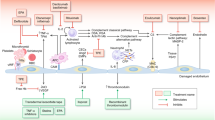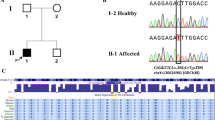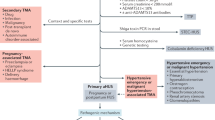Abstract
Both hemolytic uremic syndrome (HUS) and thrombotic thrombocytopenic purpura (TTP) are characterized by thrombotic microangiopathy (TMA), affecting mainly the kidney and brain, respectively. Diagnosis of HUS or TTP has been complicated by the fact that these disorders share several clinical characteristics, and by the dearth of knowledge regarding the pathogenesis of TMA. Advances in the identification of pathogenic features—deficiency of the metalloprotease ADAMTS13 in TTP and association of mutated complement proteins with atypical HUS—have gone some way towards improving clinicians' ability to distinguish between the two diseases. Here, we pose the following question: is it important to patient management that HUS be distinguished from TTP? By discussing what is known about the pathogenesis, clinical features and treatment of these two conditions we address this question, and propose a new nomenclature for TMA.
Key Points
-
The primary sites of thrombotic microangiopathy (TMA) in hemolytic uremic syndrome (HUS) and thrombotic thrombocytopenic purpura (TTP) are the kidney and brain, respectively
-
Distinguishing between HUS and TTP on the basis of simple, dichotomous clinical criteria (HUS, mild thrombocytopenia and a serum creatinine level >200 µmol/l [2.3 mg/dl]; TTP, severe thrombocytopenia and serum creatinine level <120 µmol/l [1.4 mg/dl]) is problematic as there is often overlap in clinical presentation between patients with the two disorders
-
Recent pathogenic insights (association of mutated complement proteins with atypical HUS and deficiency of the metalloprotease ADAMTS13 in TTP) have made it easier to differentiate between HUS and TTP
-
Adopting a new nomenclature—'complement-dysregulation-related TMA' and 'ADAMTS13-deficiency-related TMA', in place of 'TTP' and 'HUS', respectively—might facilitate more-effective clinical management of patients
This is a preview of subscription content, access via your institution
Access options
Subscribe to this journal
Receive 12 print issues and online access
$209.00 per year
only $17.42 per issue
Buy this article
- Purchase on Springer Link
- Instant access to full article PDF
Prices may be subject to local taxes which are calculated during checkout


Similar content being viewed by others
References
Tarr PI et al. (2005) Shiga-toxin-producing Escherichia coli and haemolytic uraemic syndrome. Lancet 365: 1073–1086
Furlan M et al. (1998) von Willebrand factor-cleaving protease in thrombotic thrombocytopenic purpura and the hemolytic-uremic syndrome. N Engl J Med 339: 1578–1584
Levy GG et al. (2001) Mutations in a member of the ADAMTS gene family cause thrombotic thrombocytopenic purpura. Nature 413: 488–494
Tsai HM and Lian EC (1998) Antibodies to von Willebrand factor-cleaving protease in acute thrombotic thrombocytopenic purpura. N Engl J Med 339: 1585–1594
Moake JL et al. (1982) Unusually large plasma factor VIII: von Willebrand factor multimers in chronic relapsing thrombotic thrombocytopenic purpura. N Engl J Med 307: 1432–1435
Caprioli J et al. (2006) Genetics of HUS: the impact of MCP, CFH and IF mutations on clinical presentation, response to treatment, and outcome. Blood 108: 1267–1279
Dragon-Durey MA and Frémeaux-Bacchi V (2005) Atypical haemolytic uraemic syndrome and mutations in complement regulator genes. Springer Semin Immun 27: 359–374
Uemura M et al. (2005) Localization of ADAMTS13 to the stellate cells of human liver. Blood 106: 922–924
Liu L et al. (2005) Platelet-derived VWF-cleaving metalloprotease ADAMTS-13. J Thromb Haemost 3: 2536–2544
Plaimauer B et al. (2002) Cloning, expression, and functional characterization of the von Willebrand factor-cleaving protease (ADAMTS13). Blood 100: 3626–3632
Wu JJ et al. (2006) Characterization of a core binding site for ADAMTS-13 in the A2 domain of von Willebrand factor. Proc Natl Acad Sci USA 103: 18470–18474
Gao W et al. (2006) Exosite interactions contribute to tension-induced cleavage of von Willebrand factor by the antithrombotic ADAMTS13 metalloprotease. Proc Natl Acad Sci USA 103: 19099–19104
De Cristofaro R et al. (2006) Molecular mapping of the chloride-binding site in von Willebrand factor (VWF): energetics and conformational effects on the VWF/ADAMTS-13 interaction. J Biol Chem 281: 30400–30411
Dong JF (2005) Cleavage of ultra-large von Willebrand factor by ADAMTS-13 under flow conditions. J Thromb Haemost 3: 1710–1716
Zheng X et al. (2003) Cleavage of von Willebrand factor requires the spacer domain of the metalloprotease ADAMTS13. J Biol Chem 278: 30136–30141
Veyradier A et al. (2004) Ten candidate ADAMTS13 mutations in six French families with congenital thrombotic thrombocytopenic purpura (Upshaw–Schulman syndrome). J Thromb Haemost 2: 424–429
Furlan M et al. (1998) Acquired deficiency of von Willebrand factor-cleaving protease in a patient with thrombotic thrombocytopenic purpura. Blood 91: 2839–2846
Luken BM et al. (2005) The spacer domain of ADAMTS13 contains a major binding site for antibodies in patients with thrombotic thrombocytopenic purpura. Thromb Haemost 93: 267–274
Klaus C et al. (2004) Epitope mapping of ADAMTS13 autoantibodies in acquired thrombotic thrombocytopenic purpura. Blood 103: 4514–4519
Miyata T et al. (2005) Measurement of ADAMTS13 activity and inhibitors. Curr Opin Hematol 12: 384–389
Vesely SK et al. (2003) ADAMTS13 activity in thrombotic thrombocytopenic purpura-hemolytic uremic syndrome: relation to presenting features and clinical outcomes in a prospective cohort of 142 patients. Blood 102: 60–68
Veyradier A et al. (2001) Specific von Willebrand factor-cleaving protease in thrombotic microangiopathies: a study of 111 cases. Blood 98: 1765–1772
Rieger M et al. (2005) ADAMTS13 autoantibodies in patients with thrombotic microangiopathies and other immunomediated diseases. Blood 106: 1262–1267
Scheiflinger F et al. (2003) Nonneutralizing IgM and IgG antibodies to von Willebrand factor-cleaving protease (ADAMTS-13) in a patient with thrombotic thrombocytopenic purpura. Blood 102: 3241–3243
Banno F et al. (2006) Complete deficiency in ADAMTS13 is prothrombotic, but it alone is not sufficient to cause thrombotic thrombocytopenic purpura. Blood 107: 3161–3166
Coppo P et al. (2004) Severe ADAMTS13 deficiency in adult idiopathic thrombotic microangiopathies defines a subset of patients characterized by various autoimmune manifestations, lower platelet count, and mild renal involvement. Medicine (Baltimore) 83: 233–244
Amoura Z et al. (2004) Thrombotic thrombocytopenic purpura with severe ADAMTS-13 deficiency in two patients with primary antiphospholipid syndrome. Arthritis Rheum 50: 3260–3264
Hirata S et al. (2006) Deficient activity of von Willebrand factor-cleaving protease in thrombotic thrombocytopenic purpura in the setting of adult-onset Still's disease. Rheumatology (Oxford) 45: 1046–1047
Matsuda J et al. (2002) Occurrence of thrombotic thrombocytopenic purpura in a systemic lupus erythematosus patient with antiphospholipid antibodies in association with a decreased activity of von Willebrand factor-cleaving protease. Lupus 11: 463–464
Bohm M et al. (2005) The course of ADAMTS-13 activity and inhibitor titre in the treatment of thrombotic thrombocytopenic purpura with plasma exchange and vincristine. Br J Haematol 129: 644–652
Zheng XL et al. (2004) Effect of plasma exchange on plasma ADAMTS13 metalloprotease activity, inhibitor level, and clinical outcome in patients with idiopathic and nonidiopathic thrombotic thrombocytopenic purpura. Blood 103: 4043–4049
Coppo P et al. (2006) Prognostic value of inhibitory anti-ADAMTS13 antibodies in adult-acquired thrombotic thrombocytopenic purpura. Br J Haematol 132: 66–74
George JN (2006) Clinical practice: thrombotic thrombocytopenic purpura. N Engl J Med 354: 1927–1935
Fakhouri F et al. (2005) Efficiency of curative and prophylactic treatment with rituximab in ADAMTS13-deficient thrombotic thrombocytopenic purpura: a study of 11 cases. Blood 106: 1932–1937
Thompson RA and Winterborn MH (1981) Hypocomplementaemia due to a genetic deficiency of beta 1H globulin. Clin Exp Immunol 46: 110–119
Warwicker P et al. (1998) Genetic studies into inherited and sporadic hemolytic uremic syndrome. Kidney Int 53: 836–844
Goicoechea de Jorge E et al. (2007) Gain-of-function mutations in complement factor B are associated with atypical hemolytic uremic syndrome. Proc Natl Acad Sci USA 104: 240–245
Esparza-Gordillo J et al. (2006) Insights into hemolytic uremic syndrome: segregation of three independent predisposition factors in a large, multiple affected pedigree. Mol Immunol 43: 1769–1775
Rodriguez de Cordoba S et al. (2004) The human complement factor H: functional roles, genetic variations and disease associations. Mol Immunol 41: 355–367
Saunders RE et al. (2006) The interactive factor H-atypical hemolytic uremic syndrome mutation database and website: update and integration of membrane cofactor protein and factor I mutations with structural models. Hum Mutat 28: 222–234
Venables JP et al. (2006) Atypical haemolytic uraemic syndrome associated with a hybrid complement gene. PLoS Med 3: e431
Dragon-Durey MA et al. (2004) Heterozygous and homozygous factor H deficiencies associated with hemolytic uremic syndrome or membranoproliferative glomerulonephritis: report and genetic analysis of 16 cases. J Am Soc Nephrol 15: 787–795
Richards A et al. (2007) Implications of the initial mutations in membrane cofactor protein (MCP; CD46) leading to atypical hemolytic uremic syndrome. Mol Immunol 44: 111–122
Frémeaux-Bacchi V et al. (2006) Genetic and functional analyses of membrane cofactor protein (CD46) mutations in atypical hemolytic uremic syndrome. J Am Soc Nephrol 17: 2017–2025
Frémeaux-Bacchi V et al. (2004) Complement factor I: a susceptibility gene for atypical haemolytic uraemic syndrome. J Med Genet 41: e84
Kavanagh D et al. (2005) Mutations in complement factor I predispose to development of atypical hemolytic uremic syndrome. J Am Soc Nephrol 16: 2150–2155
Dragon-Durey MA et al. (2005) Anti-Factor H autoantibodies associated with atypical hemolytic uremic syndrome. J Am Soc Nephrol 16: 555–563
Hosler GA et al. (2003) Thrombotic thrombocytopenic purpura and hemolytic uremic syndrome are distinct pathologic entities: a review of 56 autopsy cases. Arch Pathol Lab Med 127: 834–839
Motto DG et al. (2005) Shigatoxin triggers thrombotic thrombocytopenic purpura in genetically susceptible ADAMTS13-deficient mice. J Clin Invest 115: 2752–2761
Nolasco LH et al. (2005) Hemolytic uremic syndrome-associated Shiga toxins promote endothelial-cell secretion and impair ADAMTS13 cleavage of unusually large von Willebrand factor multimers. Blood 106: 4199–4209
Noris M et al. (2005) Complement factor H mutation in familial thrombotic thrombocytopenic purpura with ADAMTS13 deficiency and renal involvement. J Am Soc Nephrol 16: 1177–1183
Davin JC et al. (2006) Complement factor H-associated atypical hemolytic uremic syndrome in monozygotic twins: concordant presentation, discordant response to treatment. Am J Kidney Dis 47: e27–e30
Cataland SR et al. (2007) Rapid determination of ADAMTS13 activity improves clinical decision-making. Am J Hematol 82: 251
Rick ME et al. (2004) Clinical usefulness of a functional assay for the von Willebrand factor cleaving protease (ADAMTS 13) and its inhibitor in a patient with thrombotic thrombocytopenic purpura. Am J Hematol 75: 96–100
Wu JJ et al. (2006) A rapid enzyme-linked assay for ADAMTS-13. J Thromb Haemost 4: 129–136
Author information
Authors and Affiliations
Corresponding author
Ethics declarations
Competing interests
The authors declare no competing financial interests.
Rights and permissions
About this article
Cite this article
Fakhouri, F., Frémeaux-Bacchi, V. Does hemolytic uremic syndrome differ from thrombotic thrombocytopenic purpura?. Nat Rev Nephrol 3, 679–687 (2007). https://doi.org/10.1038/ncpneph0670
Received:
Accepted:
Issue Date:
DOI: https://doi.org/10.1038/ncpneph0670
This article is cited by
-
Randomized multicenter noninferiority phase III clinical trial of the first biosimilar of eculizumab
Annals of Hematology (2021)
-
Atypical hemolytic uremic syndrome
Orphanet Journal of Rare Diseases (2011)
-
Thrombotische Mikroangiopathie (TMA): neue Aspekte
Der Nephrologe (2010)
-
Thrombotische Mikroangiopathien
Der Nephrologe (2008)



